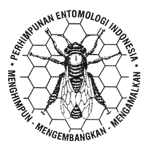Identifikasi kutukebul (Hemiptera: Aleyrodidae) dari beberapa tanaman inang dan perkembangan populasinya
DOI:
https://doi.org/10.5994/jei.3.1.41Keywords:
Diversity, whiteflies, populationAbstract
Whiteflies (Hemiptera: Aleyrodidae) can cause direct and indirect damages on plants, especially vegetables. There is only limited information regarding taxonomy and population dynamic of whiteflies attacking vegetables in Indonesia. This research is conducted to identify species of whitefly collected from chili pepper, tomato, and soybean, and to study their population dynamic. The information gathered from these studies will be useful to support whitefly management in the field. Based on morphology identification of the puparium collected directly from the host plants, there were four species of whitefly identified from chili pepper, tomato, and soybean in Bogor, Cianjur, and Sukabumi, i.e. Bemisia tabaci, Aleurodicus dispersus, Trialeurodes vaporariorum, and Dialeurodes sp. The presence of B. tabaci on chili pepper and tomato was associated with virus infection that causes yellowing and leaf curl disease. This population of B. tabaci tended to increase along with plant growth and generally reached the highest population when the plant was 60-70 days after planting.Downloads
Downloads
Published
How to Cite
Issue
Section
License
Authors who publish with this journal agree to the following terms:
- Authors retain copyright and grant the journal right of first publication with the work simultaneously licensed under a Creative Commons Attribution 4.0 International License that allows others to share the work with an acknowledgement of the work's authorship and initial publication in this journal.
- Authors are able to enter into separate, additional contractual arrangements for the non-exclusive distribution of the journal's published version of the work (e.g., post it to an institutional repository or publish it in a book), with an acknowledgement of its initial publication in this journal.
- Authors are permitted and encouraged to post their work online (e.g., in institutional repositories or on their website) prior to and during the submission process, as it can lead to productive exchanges, as well as earlier and greater citation of published work (See The Effect of Open Access).








